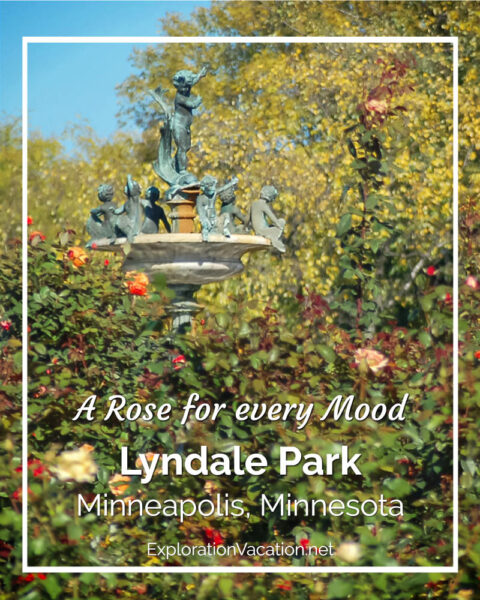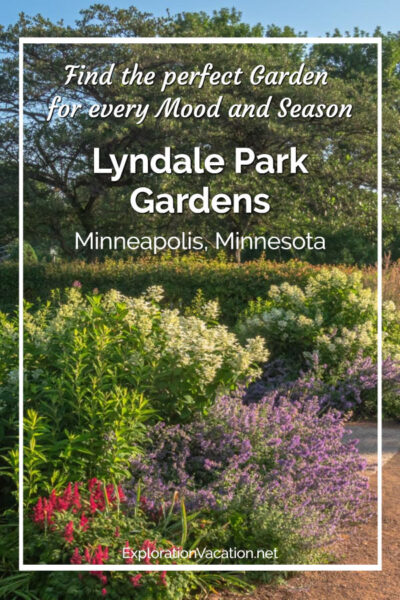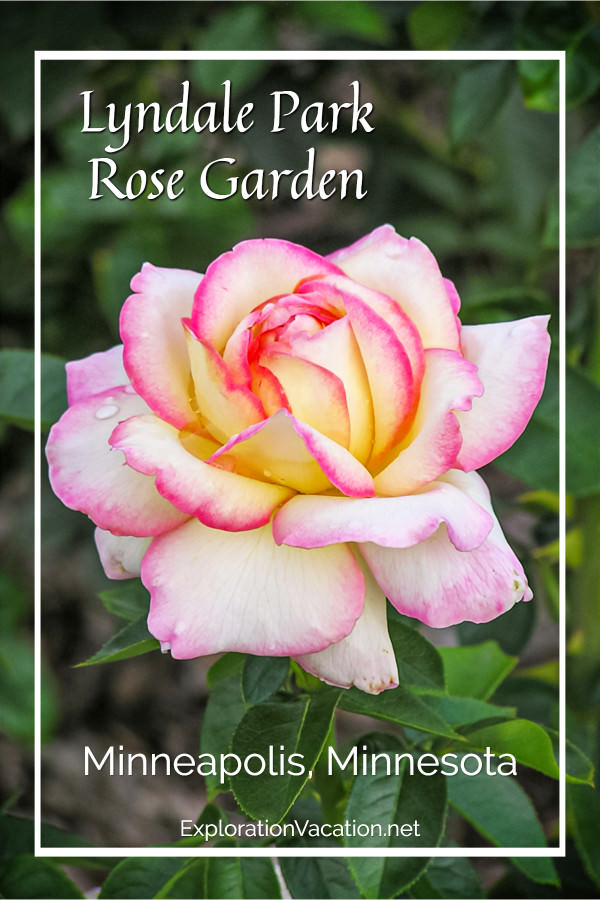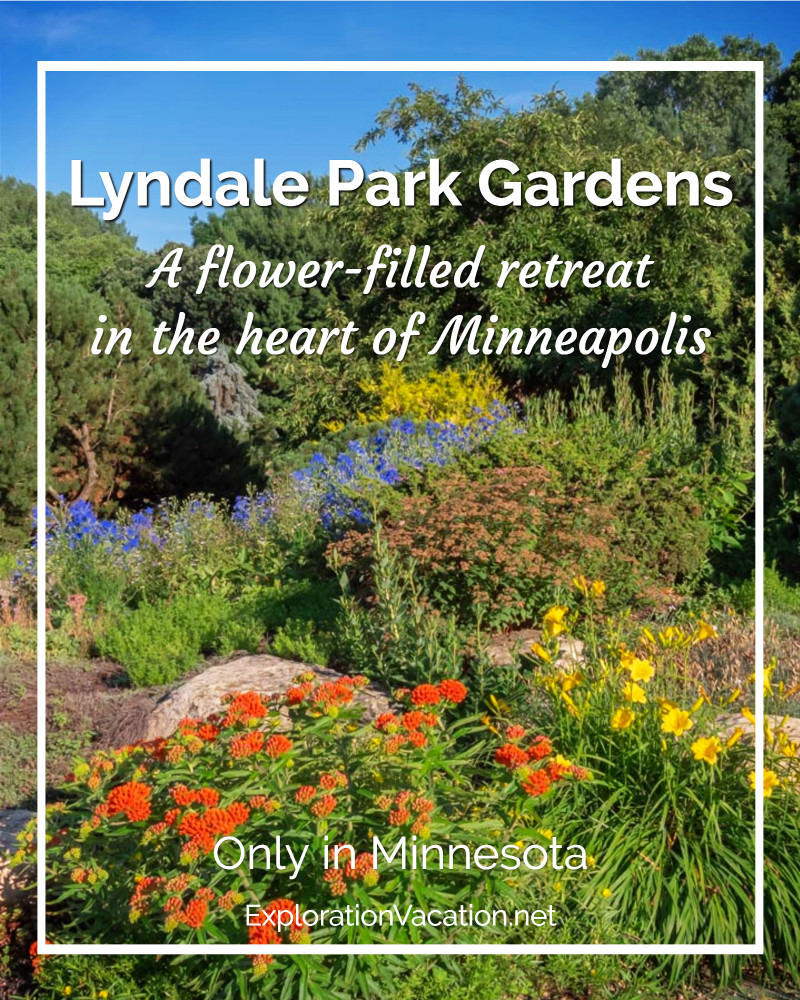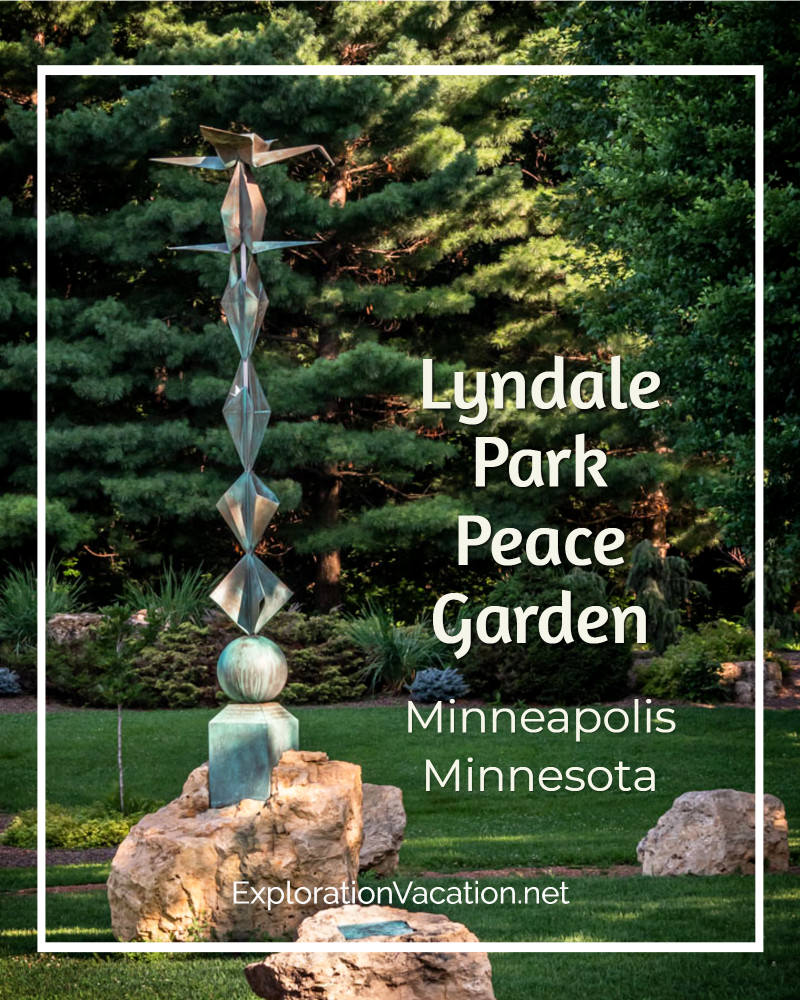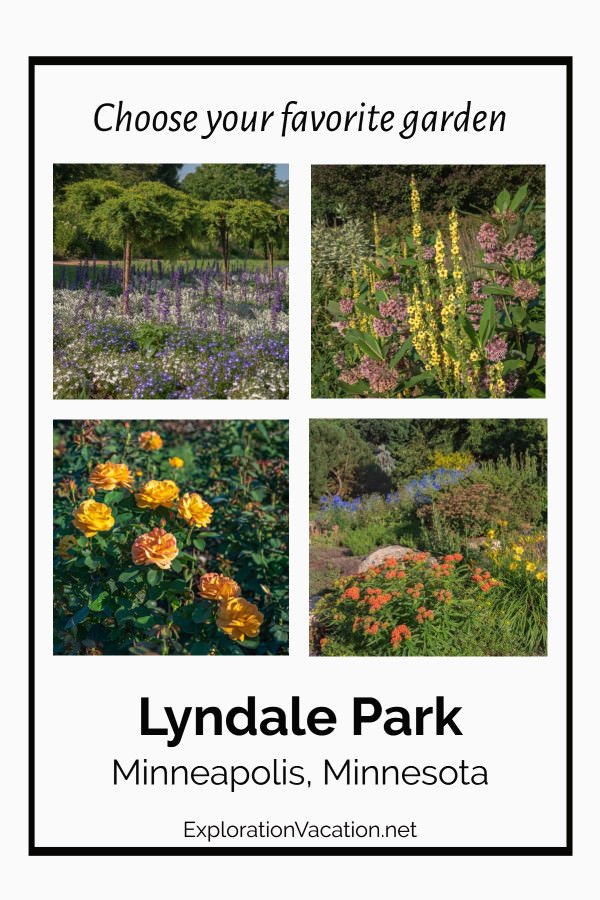Last updated on September 4th, 2023
For gardens that show off a wide variety of plants, the best gardens in Minneapolis are hidden in a quiet neighborhood just north of Lake Harriet in Lyndale Park. While the lake draws many visitors, relatively few cross the street to visit the gardens. That makes it a perfect escape in almost any season.
The Lyndale Park gardens feature three distinct garden styles: a rose garden, a Japanese peace garden, and a variety of mixed annual and perennial flower gardens. Whether you prefer subtle greenery or bold flowers, formal plantings or a wild jumble, sun or shade, you’ll find a garden or two to love!

I use links in all of my posts to improve your experience. Some may be affiliate links that pay me a small commission if you use one to reserve a room, rent a car, or purchase goods or services. You don’t pay anything extra, but it helps keep this website running. To learn more, review my policies and disclosures.
Three gardens in Lyndale Park offer greenery for every taste
Variety is a big part of what makes Lyndale Park Gardens the “best gardens in Minneapolis.” Colorful flowers that attract hummingbirds, bees, and butterflies are another. So are shady spots to relax, fountains that make it seem a little cooler on a hot summer day, and the bold colors of fall. Of course, the abundant rose blossoms, tiny Alpine flowers, and Japanese elements also add to the appeal. And, as a gardener, the well-labeled plants allow me to dream (fantasize) about creating an equally beautiful garden of my own.
Lyndale Park offers this through three very different gardens:
- The Rose Garden, which is the oldest garden. It was established in 1907 and looks the same today, except with a different mix of roses. Located across the road from Lake Harriet, this is the most well-known and busiest of the gardens.
- The Peace Garden, which began in the 1930s as a rock garden. It was abandoned fairly early on and then forgotten for decades. In the 1980s it was reborn as an Asian rock garden. In 1999 it was designated an official Peace Garden. Today it beautifully blends elements from of all these past lives.
- Although an annual and perennial flower garden came soon after the Rose Garden, the flower gardens here have moved and changed a lot over time. Today the Park Board identifies three different gardens: An Annual and Perennial Garden, Border Garden, and a Butterfly and Hummingbird Garden.
Together these form the best flower garden in Minneapolis. And you can visit it for free!
All of the gardens in Lyndale Park originated as demonstration gardens designed to educate the public about plants and how to use them in the landscape. For the most part, the gardens still serve this function. Plants are labeled in all of the gardens and new varieties are still tested here.
Minnesota gardeners will find many ideas for their own gardens here. But every visitor will discover beautiful gardens perfect for wandering. There’s no requirement that you learn anything about plants or gardening during your visit – just enjoy!
Rose Garden
The Lyndale Park Rose Garden (also sometimes called the Lake Harriet Rose Garden) is the most well-known of the Lyndale Park gardens. That’s due in part to its visibility, as it’s the only garden that can be seen from the lakeshore walking path.
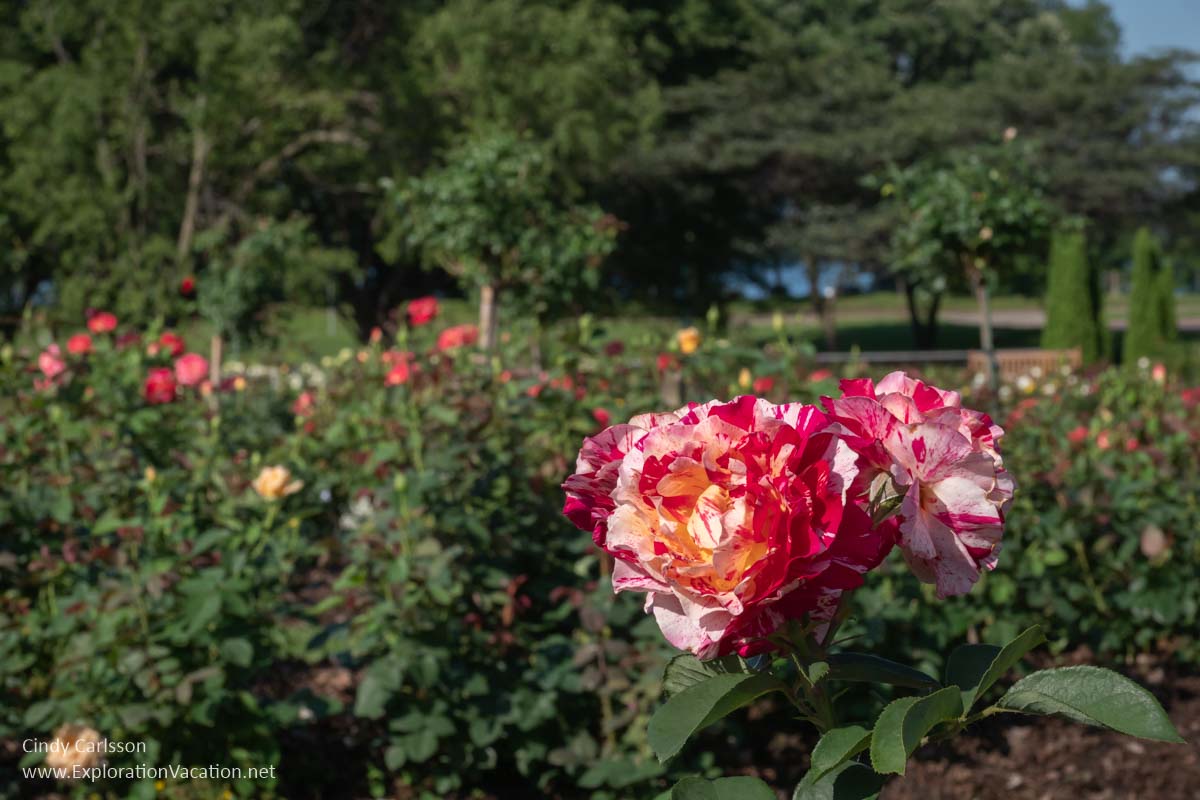
It’s also the oldest of the gardens, created in 1907 under the direction of Minneapolis Park Superintendent Theodore Wirth. Municipal rose gardens were a novelty at the time, and this was only the second in the USA. (Wirth was also created the first one in Hartford, Connecticut, before moving to Minneapolis.) But both gardens were part of a larger rose craze. For example, by this time Portland, Oregon, had 200 miles of rose-lined streets – although it would be another decade before the city established its International Rose Test Garden.
Today, the Lyndale Park Rose Garden would look very familiar to Wirth, as it retains his original layout of 62 rectangular beds of hybrid tea and other modern roses. However, He would find many new varieties growing in those beds. And, with more than 3,000 bushes representing 100 varieties, today’s Rose Garden offers everyone a bounty of fragrance and color from June through September.
The main beds of roses are surrounded by border gardens of old-fashioned roses, climbing roses, other popular garden roses, clematis, and a variety of perennials. They almost (but not quite) obscure the garden’s functional but less-than-attractive chain link fence.
But the fence, like the layout of the garden itself, is a reminder that this is a working garden. Designated an All-America Rose Selection test garden back in the 1940s, roses are grown here to test their suitability for gardeners in Minnesota’s climate. It’s about education, not artistry.
In keeping with that mission, roses are planted in large beds, generally with one variety in each, and a label at the end. Aside from border gardens and a row of tree roses that cuts the garden in half, there are no intermixed, purely ornamental plantings here.
Still, it’s wonderful to walk amid row upon row of roses – a bed of red roses followed by one with yellow or pink or peach or white roses. And, at one end of the garden, the Heffelfinger Fountain sits in a small formal area with a few mixed plantings. It’s a nod to the more traditional ornamental gardens of Europe.
Heffelfinger Fountain
The bronze and marble Italian fountain has been a focal point of the Rose Garden since 1947.
A gift of local businessman Frank Totton Heffelfinger, the fountain features a cherub riding a dolphin. He’s surrounded by a group of cherubic satyrs who appear to be having quite a party.
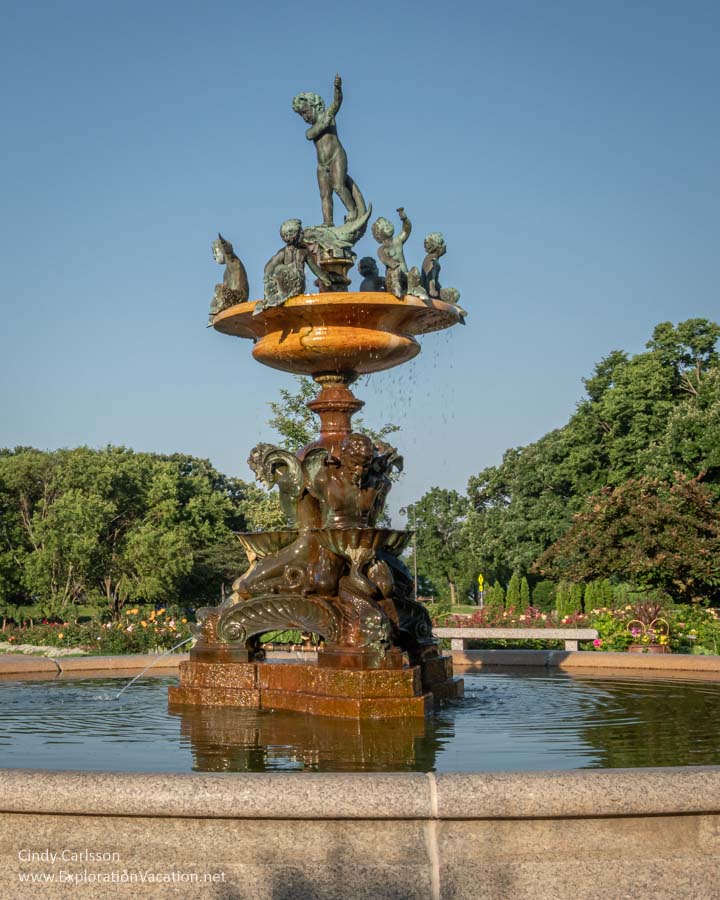
Below, and seemingly unrelated to the festivities occurring above, four human faces spout from the fountain’s pedestal. All are versions of the same male face at different points in time to show the progression of time.
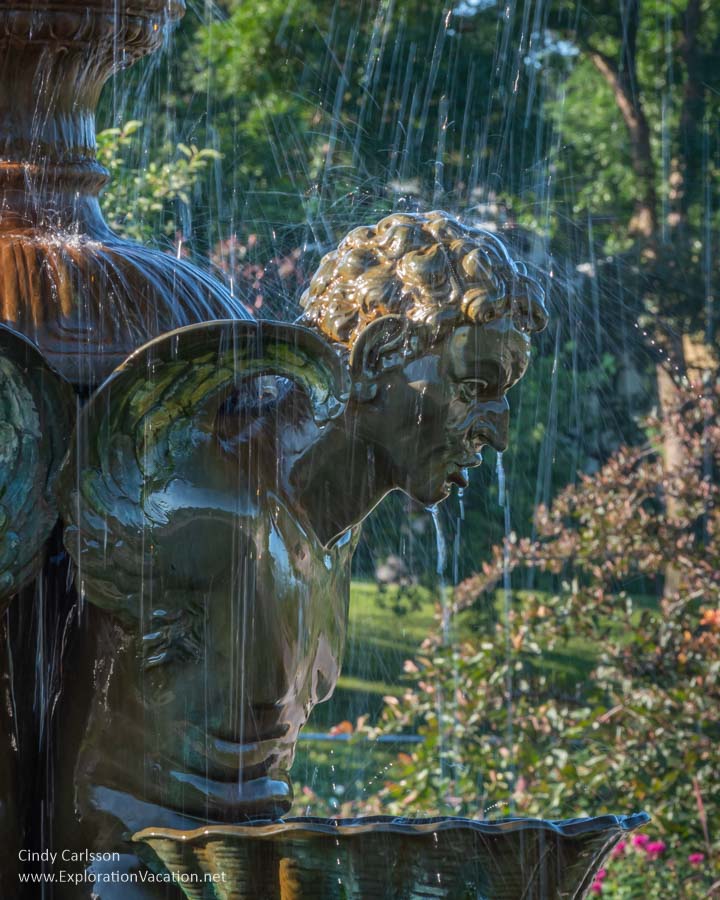
All which seems very serious compared to the frolicking cherubs above.
It’s not clear how old the fountain actually is. Heffelfinger purchased it from Villa Montalto near Florence in 1944 (or maybe in the 1920s – accounts vary), had it dismantled, and shipped it back to Minnesota. But of course, the fountain was at the villa for some time before Heffelfinger arrived. The villa itself goes back to the 14th century, but much of the exterior and gardens seem to date to the 18th and 19th century. Perhaps the fountain was added during those renovations. However, it’s hard to guess, since fanciful garden art with references to mythology were popular at various times throughout the villa’s history.
Back in Italy, Villa Montalto never replaced the fountain. The vacant base is still clearly visible in recent pictures. (Currently the entire villa is up for sale, so if you are in the market for an Italian vacation home and have plenty of money, this may be the place for you. You could even commission a replica of the fountain to “return” to its old home.)
While I’m not a huge fan of this fountain, many generations of brides have included it in their wedding pictures. And, after a complete restoration in 2012, it should continue to look good in wedding photos for years to come.
Peace Garden
The Lyndale Park Peace Garden (also sometimes called the Lake Harriet Peace Garden) is a combination Japanese-inspired peace garden and Alpine rock garden. It seems an odd combination, but the elements flow together to create a reasonably coherent, and lovely, whole.
The mix of garden styles and vegetation makes this the most interesting of the Lyndale Park gardens throughout the year. It has the earliest spring flowers, bright summer flowers, shady retreats, brilliant fall colors, and evergreens that are picture-perfect even under a fresh coat of winter snow.
It was formally recognized as an international Peace Site in 1999.
An old rock garden given new life
An Alpine rock garden was created on this site in 1929 to test flower hardiness for Minnesota.
A lot of work went into creating that rock garden, with tons of dolomite stone shipped by rail from Wisconsin to form the garden’s foundation even before planting began. Despite this effort, the garden was abandoned within a decade or two. In the years that followed it was so completely over-grown and forgotten that its discovery in the 1980s seems to have come as a complete surprise to everyone.
Look around and you’ll wonder how it was lost for so long.
Although they were rearranged when the garden was revived in the 1980s, those large white stones are the same ones shipped in from Wisconsin to create the original garden.
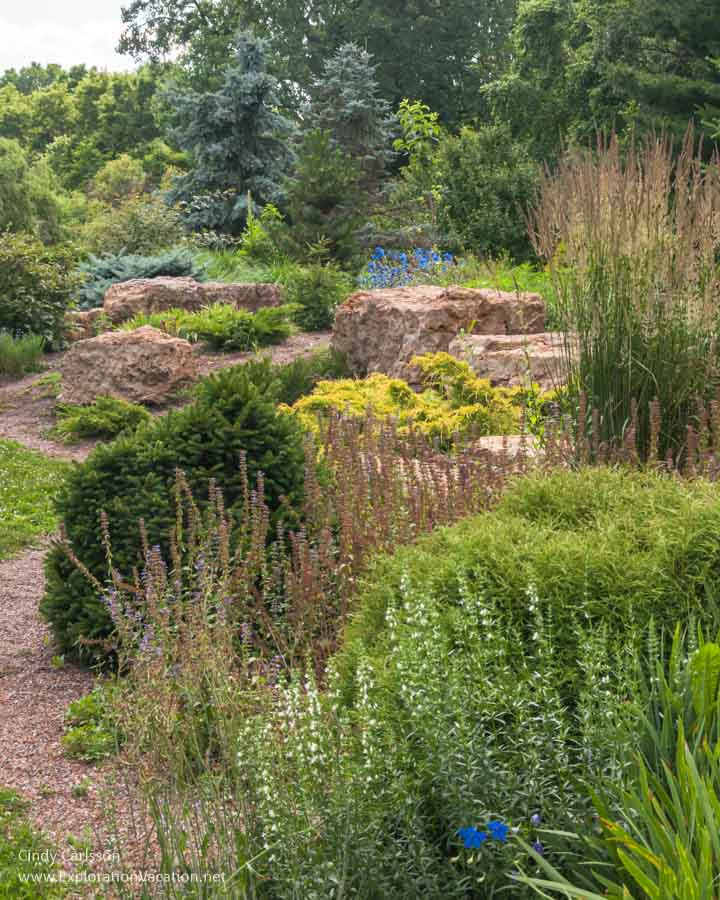
Today dolomite boulders are again all-but-buried, but this time they are hidden under a wide variety of interesting plants and small conifers. There is also a waterfall, which was first created in the 1990s and seems to have changed some in the years since.
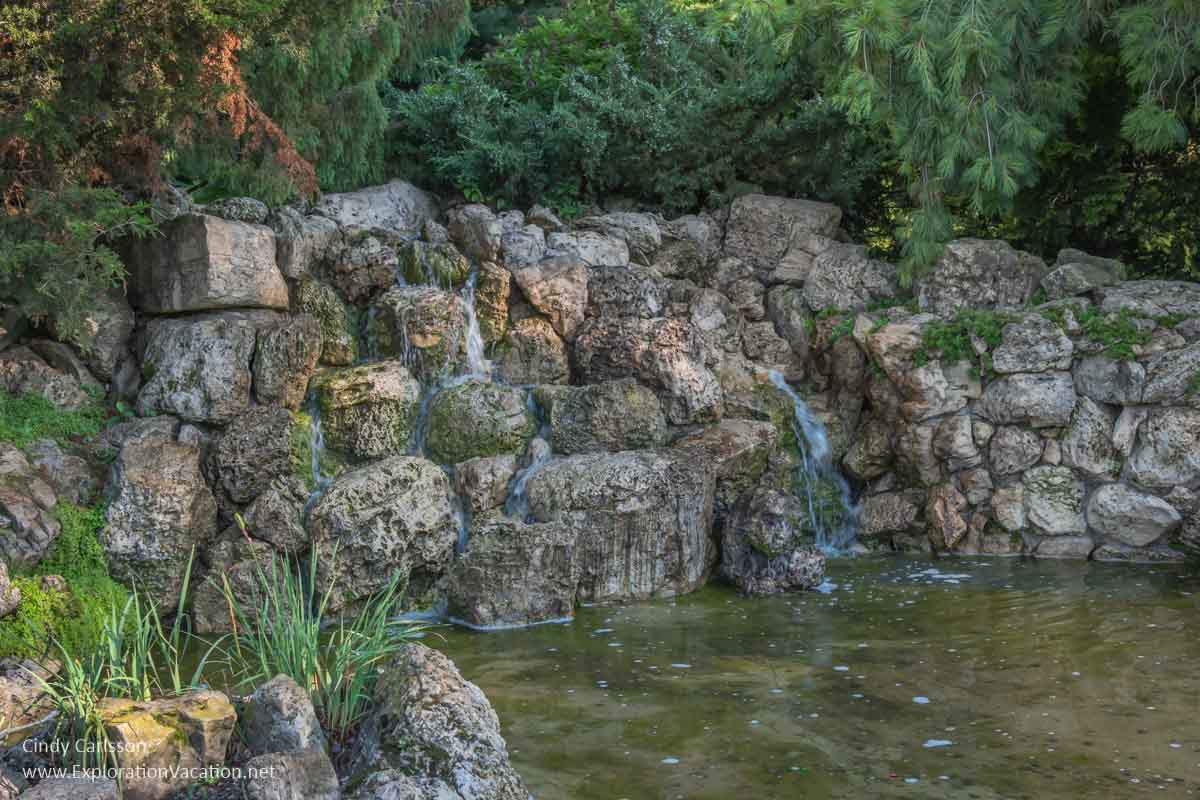
But this garden seems to always be in transition. In recent years the terraces below the Alpine rock garden have gained an increasingly large number of big, colorful perennials.
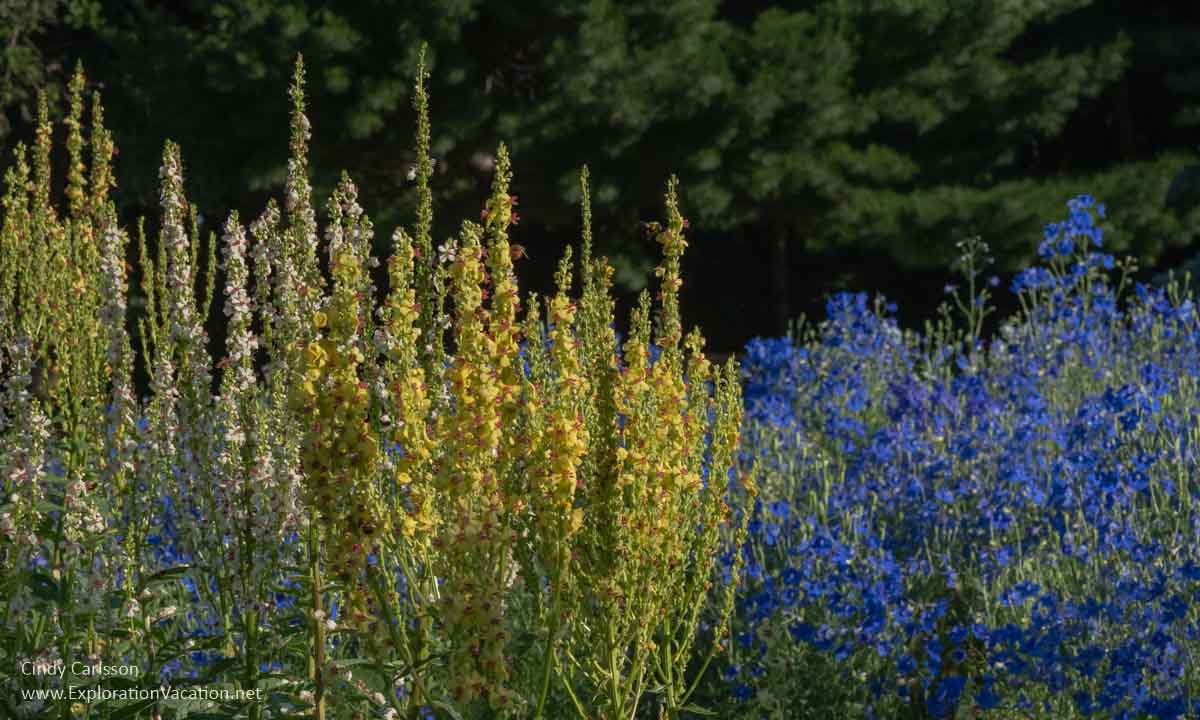
While their size is quite a contrast to the rock garden’s low-growing Alpine plants, the plantings seem to flow together. And, in early summer, it’s all a-buzz with bees.
A Japanese-inspired ode to peace
Asian, and particularly Japanese, influences can be found throughout the Peace Garden.
A Japanese bridge leads into the garden over a small wetland from one direction. From the other, a series of sculptures create a “Pathway to Peace” that directs visitors to a large peace sculpture near the waterfall. Between, a variety of conifers and other sculpture give the area the feel of a rather informal Japanese garden.
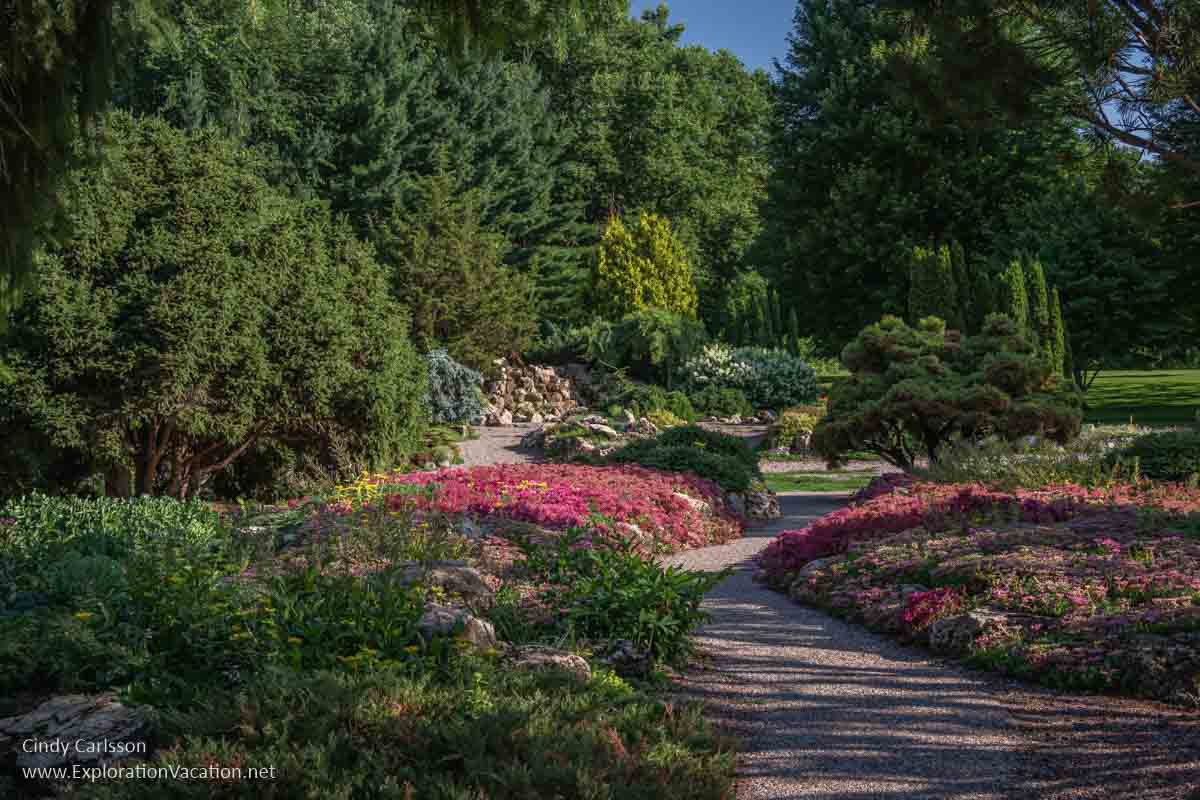
An international bridge
The original Japanese bridge was constructed in 1985. It was made of wood, but incorporated a a couple of stones from Ground Zero in Hiroshima and Nagasaki.
That bridge was replaced in 2009 with a less traditional wooden bridge.
The new bridge is built from Brazilian mahogany, Minnesota granite, and copper. But it also incorporates the two stones from Hiroshima and Nagasaki. And it follows Japanese tradition in requiring those crossing it to make a right angle turn to thwart evil spirits, who can only move in a straight line.
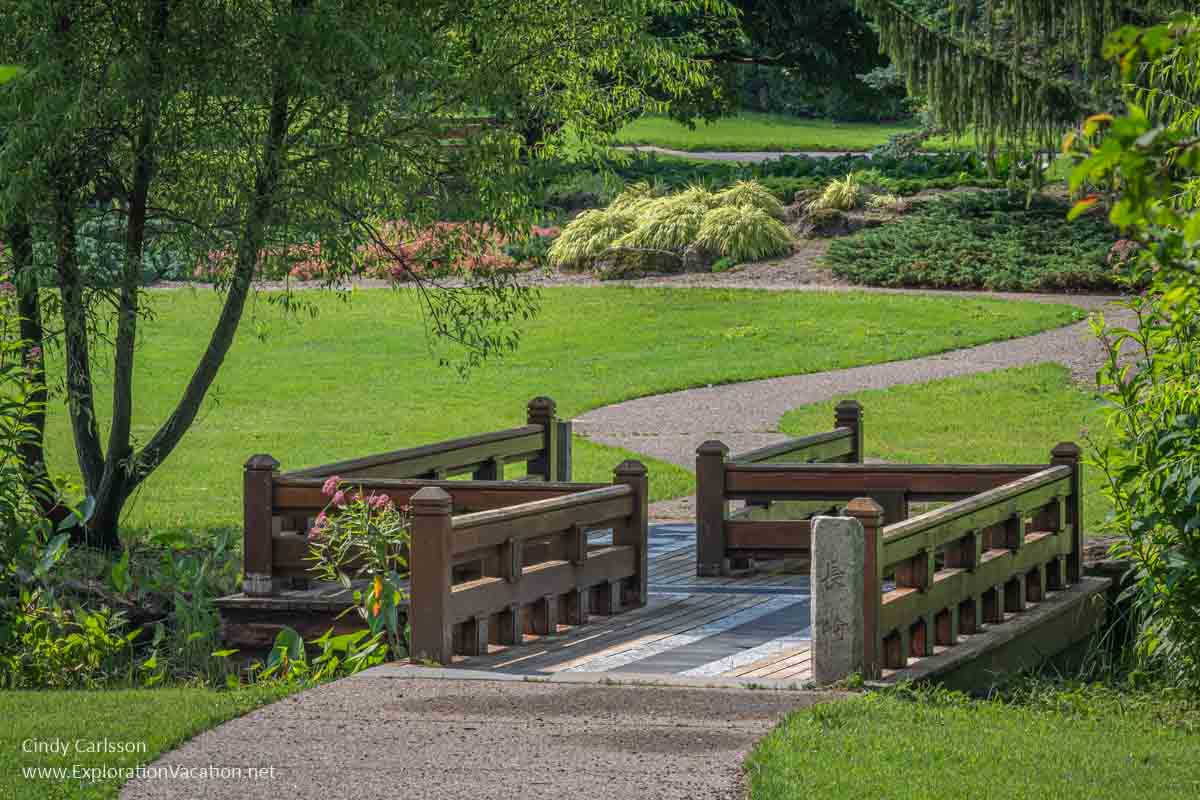
The current bridge was designed by local Japanese-American artist Kinji Akagawa (pdf) and architect Jerry Allan, both of whom taught at the Minneapolis College of Art and Design.
Sadly, the small pond below it was an overgrown mess when I visited in June 2019.
The Spirit of Peace captured in bronze
Near the waterfall, a small clearing hosts a ring of boulders. Inside that circle, a tall bronze sculpture shows a piece of paper transforming into a paper crane.

Japanese tradition holds that anyone who folds a thousand paper cranes will be granted their fondest wish. This symbol of good fortune became associated with peace by a 12-year-old survivor of the Hiroshima bombing who was dying from radiation exposure. Hoping to extend her life, she decided to fold a thousand cranes. However, she soon realized that this would not keep her alive. So, instead of continuing to fold paper cranes to save herself, she began folding them in an effort to bring about world peace and an end to suffering for all.
The Spirit of Peace sculpture recognizes her wish for peace in the form of a 12-foot tall bronze statue that captures the process of creating a paper crane. It was created by local artist Caprice Glaser and installed in 2006.
The boulders that surround the sculpture provide step by step directions for folding a paper crane.

The sculpture also includes spots designed to hold real paper cranes, so visitors can add their own.
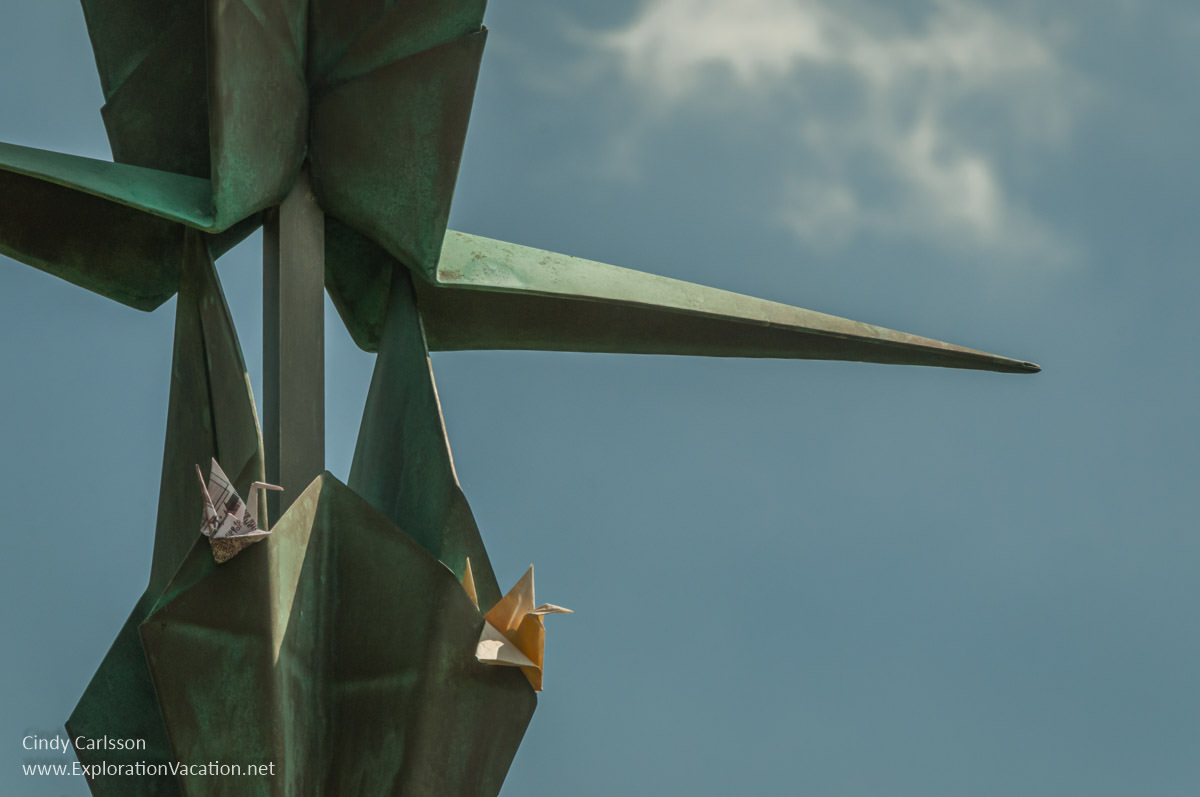
Once upon a time there was a supply of paper here specifically for folding cranes. Now it seems you have to bring your own paper – so come prepared. You’ll need a square piece of paper of any size. Follow the directions on the stones and, when your crane is complete, make your wish and tuck it into a crease in the sculpture. Perhaps someday the cumulative impact of all those cranes will result in world peace. It never hurts to hope.
Follow the neighborhood Pathway to Peace
A Pathway to Peace of seven stone sculptures connects the neighborhood to the Peace Garden.

The sculptures represent different types of cairns – piles of rock used to mark significant landmarks, important sites, and trails. Here they mark the way to peace – both as a visual guide directing visitors to the peace park and as a structure for contemplating peace.
The words written on base of each represent how the community views peace. Written in pairs, the words shift as you move around each sculpture. It’s an opportunity to slow down and reflect on the meaning of peace and how to achieve it.
The Pathway to Peace was created by local artists Teri Kwant and Greg Ingraham in conjunction with Hoisington Koegler Group as part of a collaboration with local residents.
A variety of annual and perennial flower gardens
Lyndale Park also has several mixed flower beds. All of these seem to include a variety of flowering shrubs, perennials, and a few annuals. Some gardens have a mix of all three, but annuals are really only featured in a couple of places.
The first perennial and annual gardens were planted in Lyndale Park in the 1920s and quickly became hugely popular with the public. However, over the years the flower gardens have been moved and changed. The current gardens only date back to the 1960s.
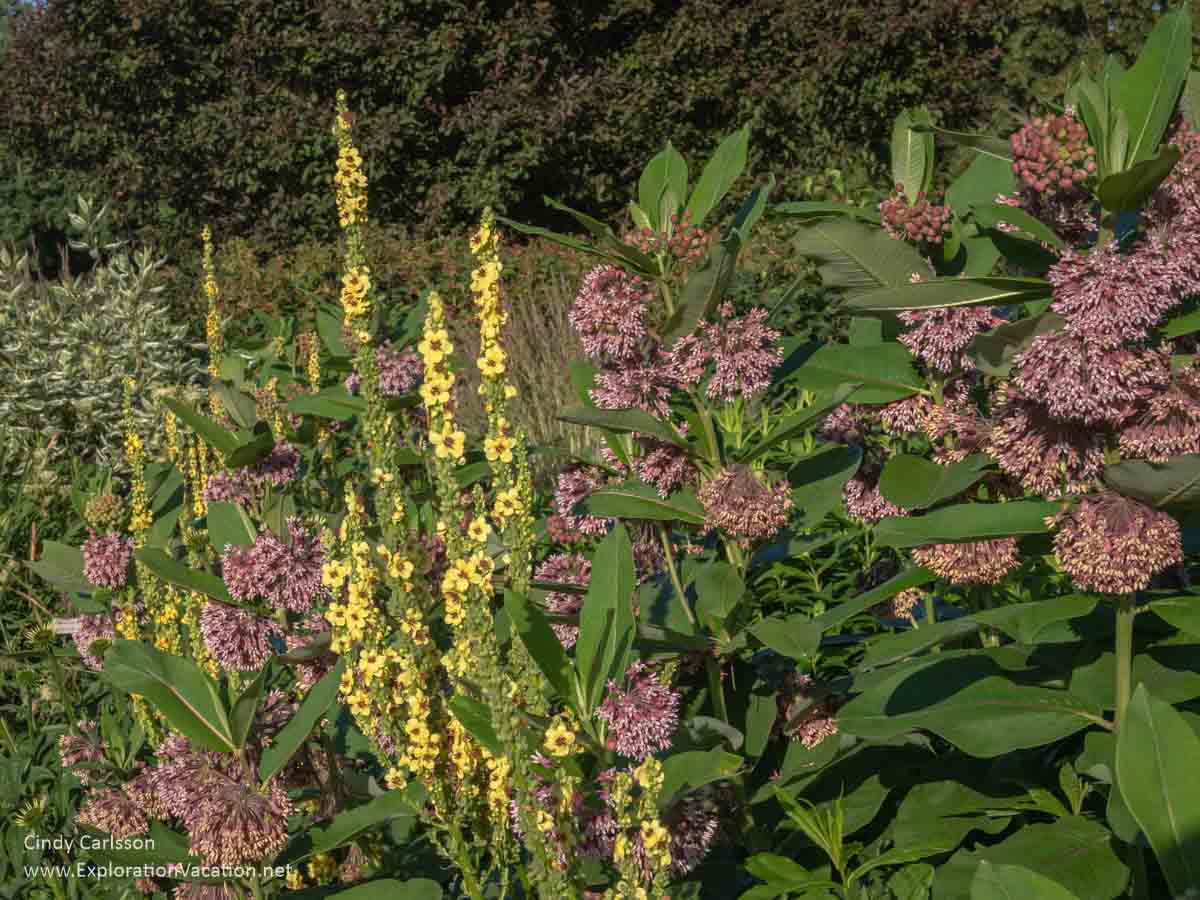
There are three named flower gardens in Lyndale Park, but none of those names make it easy to distinguish between the gardens:
- The Annual and Perennial Garden includes two large border gardens with a large number of plants beloved by pollinators and six smaller beds made up largely of annuals. It is located between the Heffelfinger and Turtle fountains.
- The Border Garden, which is still signed as the Trial Garden (its former name), contains a mix of small shrubs and trees, a wide variety of perennials, and a few annuals. It is located east of the Peace Garden along the woods.
- The Butterfly and Hummingbird Garden is a semi-wild annual and perennial garden of pollinator-friendly flowers. It’s mostly a border garden located along the woods behind the Peace Garden and immediately west of the Border Garden.
As you can see, all include a border garden, all feature many plants attractive to pollinators, all have a lot of perennials, and most have at least a few annuals! But at least the gardens are quite different in the way plants are used.
The Annual and Perennial Garden
Located just beyond the Heffelfinger Fountain by the Rose Garden, the Annual and Perennial Garden features two large border gardens with smaller garden beds in the lawn between them and another fountain at the far end.
The borders of the Annual and Perennial Garden feature an informal mix of flowering shrubs and perennials.
Between these borders, a grouping of smaller beds is much more formal in feel. Each of the six beds is planted with a different color scheme.

The Phelps Turtle Fountain
Like the Rose Garden, the Annual and Perennial garden is anchored by a fountain. In this case it is the Turtle Fountain (or Phelps Fountain), a relatively simple, but whimsical piece of art created for the Minneapolis park system.
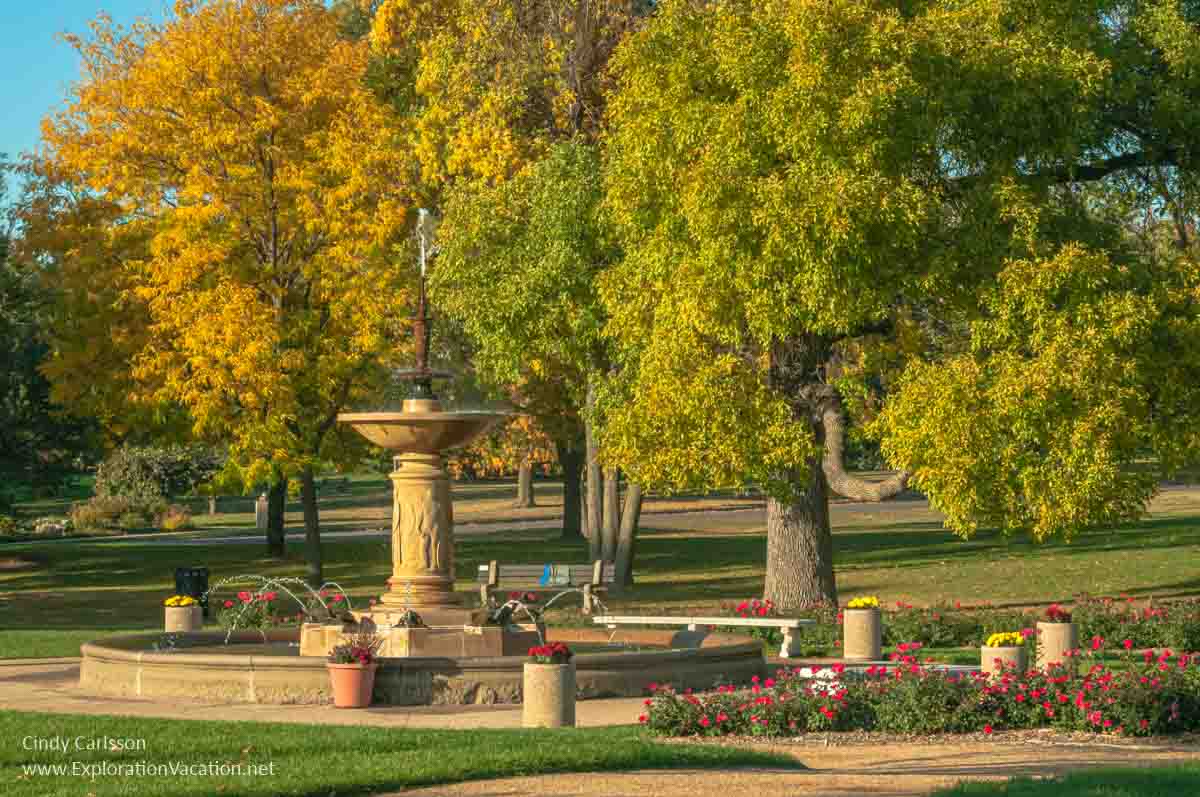
Shouldn’t every park have a fountain surrounded by water-spouting turtles?
While the Turtle Fountain is described as “in” the Annual and Perennial Garden, it is in the garden the same way the Heffelfinger fountain is “in” the Rose Garden. It’s an add-on at the end of the garden, with little landscaping immediately around it. But it’s a cool fountain.
Also, like the Heffelfinger Fountain, the Turtle Fountain was moved to the park from another location. But this fountain only came here from downtown.
A gift from Minneapolis businessman and long-time Park Commissioner Edmund Phelps, the fountain was installed in downtown Minneapolis’ Gateway Park in 1915. It remained there even as after the park’s elaborate buildings were demolished in the 1950s – right up until 1963 when the entire Gateway area was demolished. It was relocated to Lyndale Park at that time as part of the creation of the Annual and Perennial Garden.
The pedestal of the marble and bronze fountain features figures from local history, although I’m not sure who. Nor do I know why turtles decorate the fountain’s pool.
The Gateway District was once the heart of Minneapolis, but it fell on hard times. In what turned out to be a horrible choice, the entire area – 25 blocks, including 40% of the city’s historic downtown – was demolished between 1959 and 1963. Only now, 60 years later, the area is finally more than a wasteland of parking lots and crappy infill. As the again becomes a vibrant part of the city, the Turtle Fountain is almost the only remaining physical remnant of the old city.
If you are interested in learning more about the Turtle Fountain’s original home in the Gateway Plaza Park, read Down and Out: The Life and Death of Minneapolis’s Skid Row.
The Border Garden
A linear garden of perennials, flowering shrubs, and flowering trees meanders along the edge of the woods marking Lyndale Park’s northern boundary with Lakewood Cemetery. Formerly known as the Trial Garden (and still signed as such), the Border Garden is Lyndale Park’s version of a traditional home garden. It’s a very large and well-maintained version of what many backyard flower gardens aspire to.
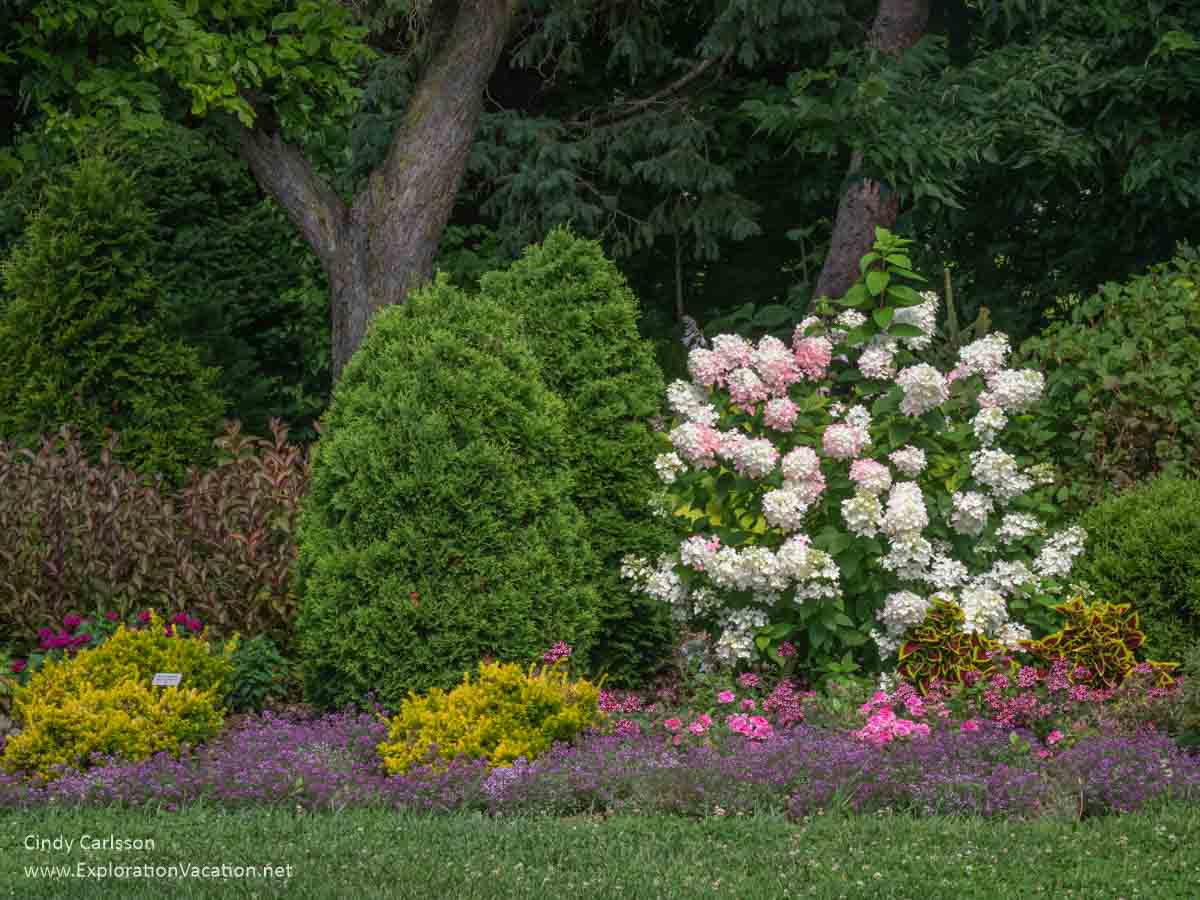
The Park Board describes this as a perennial garden, but it actually includes a mix of annuals and perennials. Apparently, it is still used to test perennials for disease resistance and suitability for Minnesota’s climate. Perhaps this is the reason perennials get top billing.
Since the mix of plants varies considerably throughout the length of the garden, so it’s worth crossing the lawn to stroll along the garden’s edge.
Along the way you’ll pass through what appears to be the remains of Wirth’s arboretum, which still has a number of large, old trees. Look for very informative labels by some of the more unusual varieties.
The Butterfly and Hummingbird Garden
The newest garden in the park, the Butterfly and Hummingbird Garden is a more informal continuation of the Border Garden. Filled with native species and other flowers that are particularly attractive to butterflies, hummingbirds, and bees, much of this garden has a wilder, more natural look than any of the other gardens in Lyndale Park. It also has a number of man-made features designed to provide shelter for pollinators.
Plan your visit to the Lyndale Park gardens
All of the gardens featured here are located in Lyndale Park. That’s just to the northeast of Lake Harriet and south of downtown. It’s tucked between the lake and Lakewood Cemetery, so there are plenty of quiet spots where you can escape the daily rush!
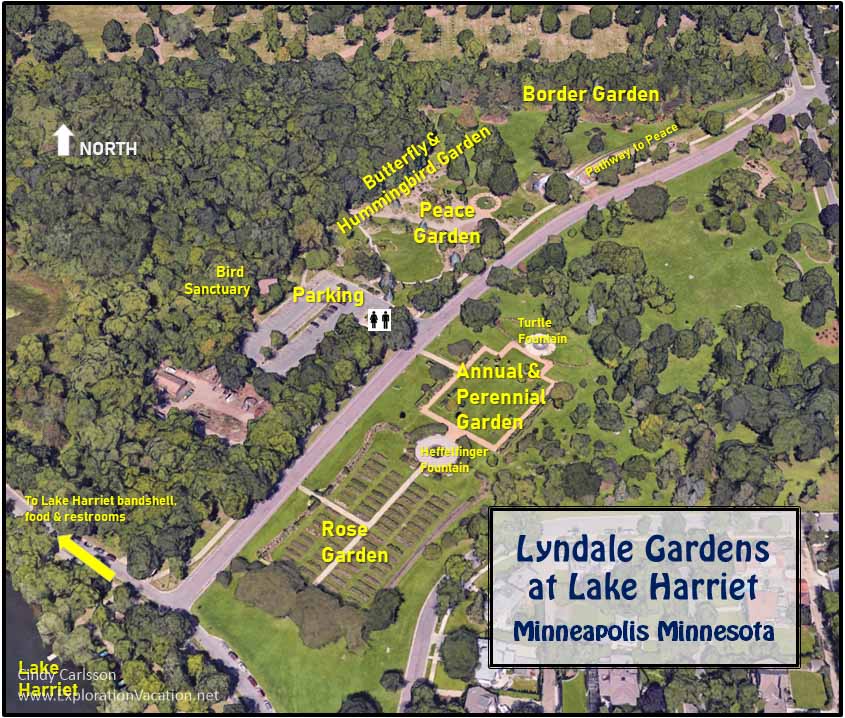
For years I’ve known these as the Lake Harriet gardens. Even Theodore Wirth, the Minneapolis park superintendent who established the gardens, thought Lyndale Park and its gardens should be part of Lake Harriet Park. But officially it remains Lyndale Park, as stipulated in the agreement that transferred the land to the Park Board.
However, no matter what you call these gardens, a visit here between May and October is one of the best free things to do in Minneapolis.
Park and garden hours
Lyndale Park, like all Minneapolis parks, is open from 6:00 am until midnight. However, the gardens are only open from 7:30 am to 10:00 pm.
In reality, the only garden that can be closed is the Rose Garden. Here gates keep visitors out when the garden is closed.
None of the other gardens are gated, but park staff will evict troublesome visitors if they find them in the park after it has closed for the night.
When to visit
The Rose Garden is only open during the growing season. The rest of the park is open all year, but the Peace Garden with its conifers is the only one that offers any real winter interest.
Rose Garden
Peak display in the Rose Garden is generally between mid-June and early October. My favorite time to visit is late June and again from mid-September into October.
A little frost doesn’t bother roses, so they are often absolutely gorgeous right up until they are put to bed for the winter in October.
On the other hand, since the roses are buried under mounds of mulch to protect them from even the coldest Minnesota winter, it takes some time after they are uncovered in spring to start growing again. June is about the earliest you’ll see blossoms. But a late June visit lets you enjoy both blossoms and healthy leaves before the Japanese beetles and summer heat take their toll.
Peace Garden
With its mix of Alpine plants, conifers, and Asian-inspired sculpture, the Peace Garden is worth a visit at any time of year. It’s even lovely when draped with winter snow. However, I think it is at its very best in spring when the most flowers are in bloom and then again in the fall when the shrubs and trees turn brilliant colors.
Annual and perennial gardens
The various annual and perennial gardens offer a varying range of blooms from mid-June until the first frost in September or October. Although there are some spring bulbs in the Annual and Perennial Garden, none of these really shine until late June or early July.
Parking at Lyndale Park Gardens and Lake Harriet
Like all of the Minneapolis Regional Parks, off-street parking is available for a fee at the gardens or at various spots along Lake Harriet. A fee or permit is required at all times in all of these parking areas.
Free parking is available (sometimes) on neighborhood streets.
But parking at Lake Harriet (or anywhere nearby) can be a challenge on summer weekends.
Amenities
There are portable toilets just inside the parking lot by the Peace Garden and Roberts Bird Sanctuary.
Additional amenities, including restrooms in a lovely historic building, a restaurant with a view of Lake Harriet, and boat rentals of all sorts are available near the band shell in Lake Harriet Park.

Looking for more free things to do in Minneapolis?
Lyndale Park is located in a beautiful residential area. But that doesn’t mean there isn’t plenty to do right in the neighborhood. Options include wildlife watching in Roberts Bird Sanctuary; walking, biking, or enjoying water sports at Lake Harriet; and touring the Chain of Lakes.
Try birdwatching at the Roberts Bird Sanctuary
One side of the Peace Garden nestles alongside the Thomas Sadler Roberts Bird Sanctuary. This is another oasis of peace, where even dogs and runners are prohibited.
A mix of woodland and marsh, the area was designated as a bird sanctuary in 1936. A decade later it was named for retired-doctor-turned-ornithologist (and my husband’s great-grandfather) Thomas Sadler Roberts. Roberts wrote the book on birding in Minnesota (literally), so it seems an apt tribute.
The water level in the sanctuary seems to be rising over time and the paths aren’t always well maintained even when not underwater. However, this is a good place to search for birds native to Minnesota as well as seasonal migrants. And you never know what other wildlife you might meet.
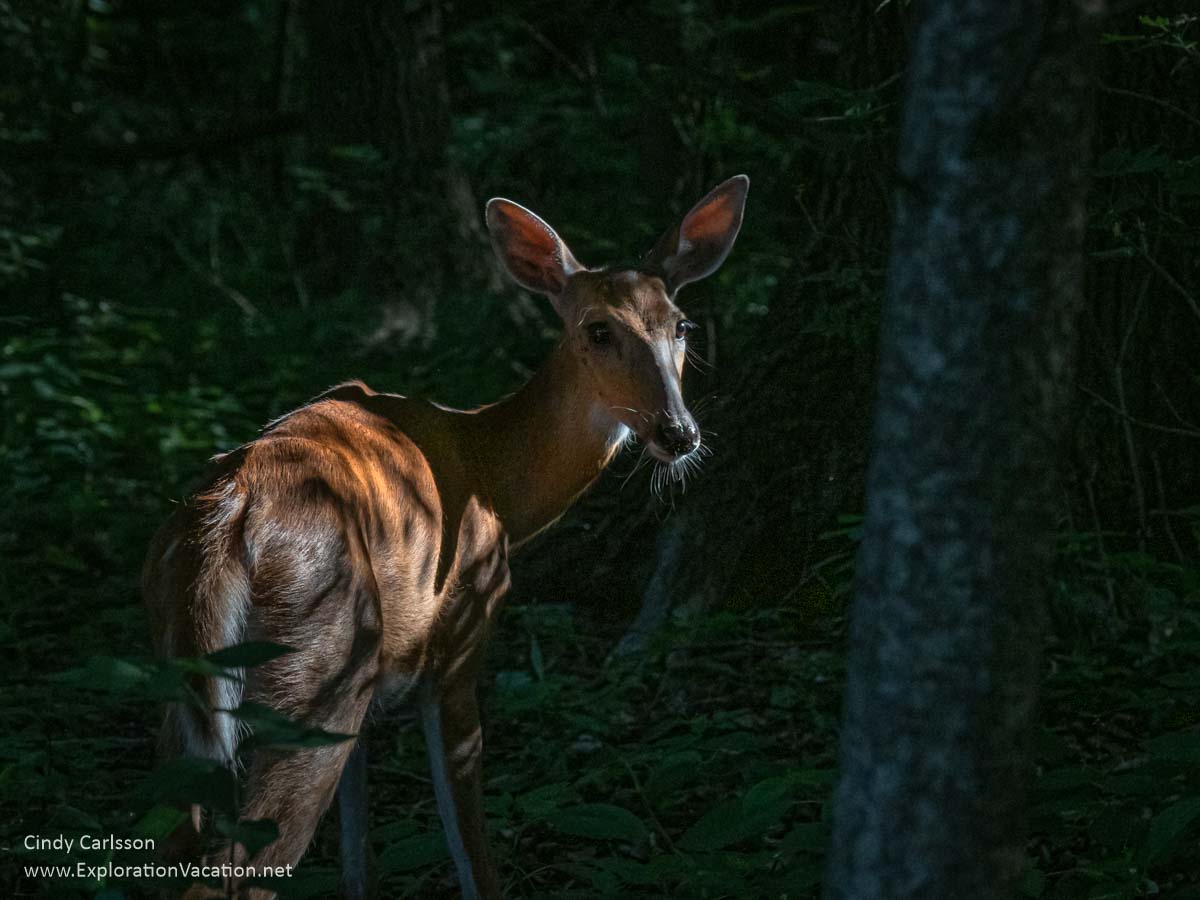
Roberts is both the founding father of birding in Minnesota and a pretty interesting character. If you are interested in birding with a side of Minneapolis history, A Love Affair with Birds is an engaging tale of Robert’s life and the city he called home.
There’s an activity for everyone at Lake Harriet
For the most part, Lake Harriet Park really only includes land right along the lakeshore. But within that limited strip you will find walking and biking paths, two beaches, a fishing pier, small garden, playground, boat dock, band shell, café, and a spot to rent a bike, canoe, kayak, boat, or paddle board.
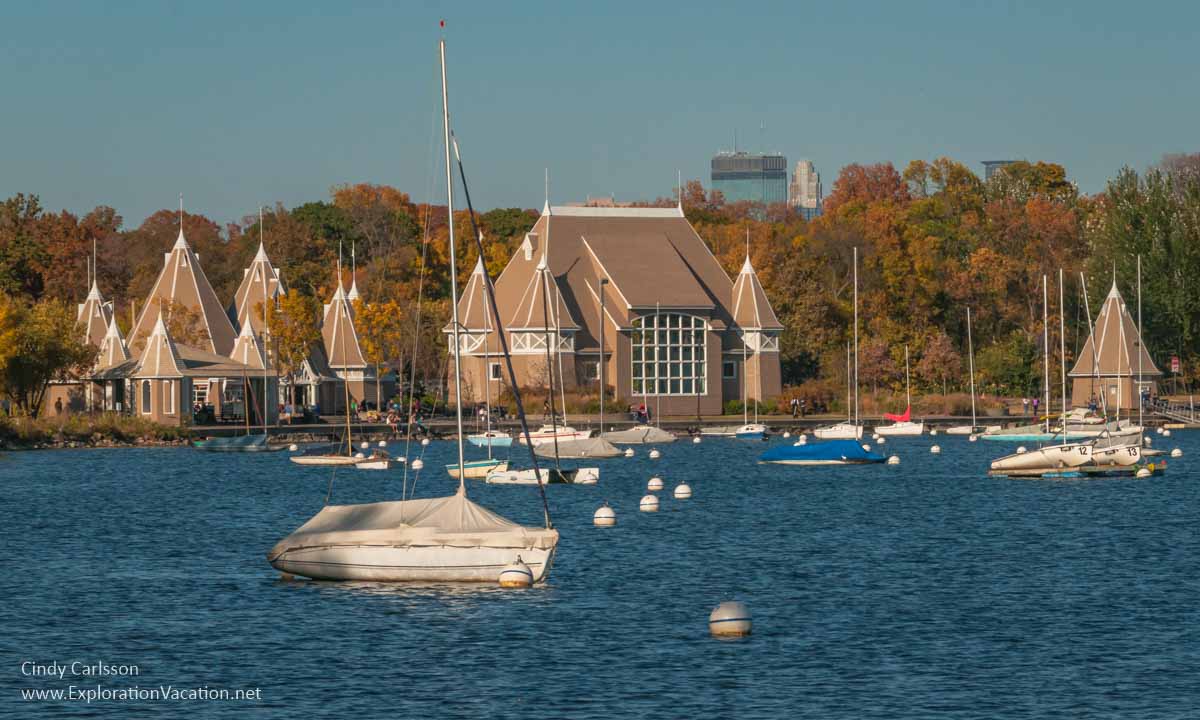
This is one of the oldest parks in Minneapolis, authorized in 1883. Boating, concerts and biking have been popular activities here since the park’s earliest days.
The first entertainment pavilion was built in the park 1892 to replace an adjacent privately-owned one that burned down. (The current band shell was built in 1986 to replace a temporary structure from the 1920s.)
The park’s bike trails date back to the bicycle craze of the 1890s. Today those same bike and pedestrian paths, offer water fowl sightings, iconic views over the lake, and a glimpse of the fancy houses on the hills above the lake.
And, as in the past, concerts, theatrical performances, and movies are also offered at the Lake Harriet band shell throughout the summer.
While picnics are always appropriate, the Lake Harriet pavilion houses a café selling light meals, ice cream, and snacks.

Explore farther afield in the Minneapolis Chain of Lakes Regional Park
Like Lake Harriet Park, Lyndale Park is part of the Minneapolis Chain of Lakes Regional Park.
Minneapolis has one of the finest urban park systems in the USA, and the Chain of Lakes Regional Park is the city’s gem. 15 miles each of bike and walking trails pass (mostly) through parks and natural areas to link five urban lakes and Lyndale Park. It’s a beautiful getaway right in the city. Walk, bike, or run here on a lovely day and you are guaranteed to fall in love with Minneapolis.
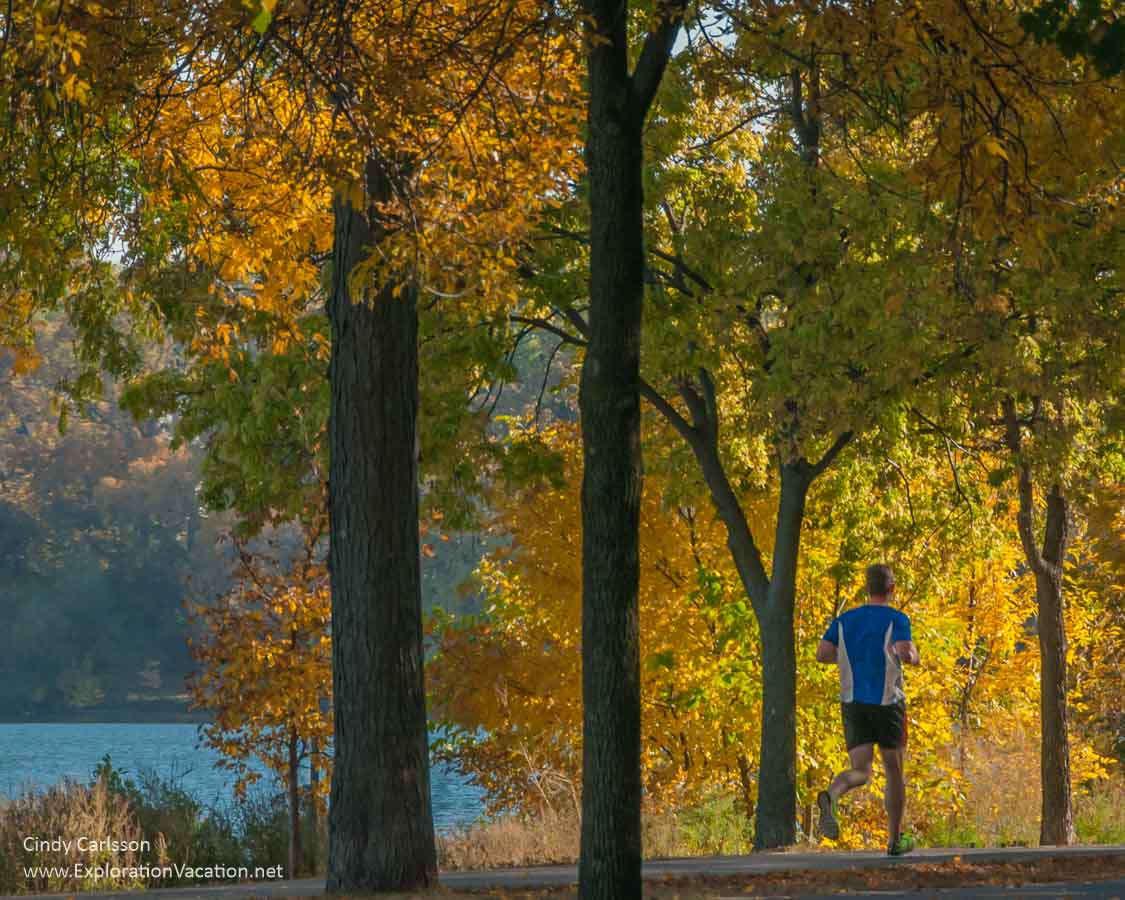
The lakes included in the Chain of Lakes Regional Park are: Brownie, Cedar, Lake of the Isles, Bde Maka Ska (formerly Calhoun), and Harriet. Some areas are well developed for recreation and include popular city beaches. Other areas remain more natural.
Trails also connects to others along Minnehaha Creek, Lake Nokomis, Minnehaha Falls, and beyond.
This is all part of the Grand Rounds Scenic Byway. This National Scenic Byway includes 50 miles each of parkways, bike trails, and walking paths connecting natural features, greenways, parks, playgrounds, gardens, and athletic fields in Minneapolis.

Much of the historical information included in this story comes from the Minneapolis Parks website.
Each park on the site has a section with history. It’s a nice way to learn a little more about the sometimes-surprising events that led to the park system we know today. The Lyndale Park history page is a particularly fact-filled look into the past.
The Park Board’s Lyndale Park Guide to the Gardens and Arboretum (PDF) also includes a wealth of current and historical information. Much of this is information not included on the park website.
The Southwest Journal also includes a number of interesting stories on Lyndale Park, including a piece from some years ago on the park’s gardeners.


Exploring Minneapolis


















